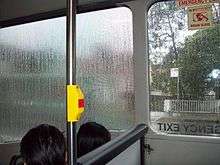Wrap advertising

Wrap advertising or a vehicle wrap describe the marketing practice of completely or partially covering (wrapping a vehicle in an advertisement or livery. The result of this process is essentially a mobile billboard. Wrap advertising can be achieved by painting a vehicle's outer surface, but an increasingly ubiquitous practice in the 21st century involves the use of large vinyl sheets as "decals". The vinyl sheets can later be removed with relative ease, drastically reducing the costs associated with changing advertisements. While vehicles with large, flat surfaces (such as buses and light-rail carriages) are often used, automobiles can also serve as hosts for wrap advertising, despite consisting of more curved surfaces. Wrap advertising is also used in the magazine and publishing industries.
Description
Using what is known as a "conformable vinyl wrapping" material, a high-quality print or protective clear wrap can be molded to almost any and every part of a vehicle. Typically, conformable material is used because it is the easiest to work with, especially on contoured surfaces. Using the proper adhesives when applying the material to the surface of the car is essential, otherwise the wrap can lead to adhesive failure in a few months after the application.
Advancements in plastics have led to new types of vinyl designed specifically for wrap advertising, including vinyl sheets that feature bubble-preventing air channels. Microscopic glass beads are used to prevent an adhesive from functioning until the user is ready (the beads allow the material to be repeatedly lifted and reapplied during the wrapping process, without compromising the longevity of the wrap). The vinyl is heated with a heat gun or torch for the purpose of molding the material around objects.[1]
Decals can be made to cover side and rear windows on a vehicle, but for safety reasons, the front windows used by the driver are not covered. The decals on side windows are typically perforated, so that it is still possible for passengers to look outside. This See-through graphic technology originated in the 1980s, with the first dominant patent registered by a British company called Contra Vision.[2] Wrapped advertisements must often be divided into a number of smaller pieces to appropriately cover any movable panels on the vehicle, such as the fuel tank cover, trunk (boot) openings, and other doors.
Wrapping is also sometimes used instead of paint as a less-permanent way of applying its operator’s standard livery. This has become particularly common in the UK where, since the privatisation of British Rail, it has become quite frequent for trains to be transferred from one company to another, requiring many changes of livery. Wrapping can also be used for vehicle customisation, and race cars often get vehicle wraps as they are lighter than paint.
For publications and magazines, this is advertising that envelopes the primary magazine in a cover allowing the reader to see the advertisement immediately upon picking up the publication. The magazine cover wrap is mostly used for business-to-business (B2B) advertising as the wrap itself protects the product when it is being transported to its subscriber.[3]
Effectiveness
Industry analysts, researchers and trade representatives have researched the effectiveness of mobile billboards. 3M and the American Trucking Associations noted 91% of the target demographic noticed the text and graphics on truck advertising, and the Traffic Audit Bureau noted that on local routes monthly impressions ranged from one to four millions hits. Product Acceptance and Research said 94% of respondents recalled seeing the Mobile Billboard, with 80% recalling the specific advertisement; the billboards resulted in a sales increase of 107%. The Ad Agency RYP & Becker Group completed the 3M Mobile Media Advertising Case Study in 2011 with the following findings: 97% of survey respondents recalled the ad, 98% thought the advertising created a positive image of the advertiser, and 96% thought fleet graphics had greater impact than billboards.
Other applications
An addition to their use as mobile billboards and advertising, vinyl vehicle wraps have also been used as an alternative to painting fleet and personal passenger vehicles. This application of vinyl film as a substitute for painting first took place in 1993 in Germany, when vinyl manufacturer KPMF was asked to produce a film that could be used on a large-scale basis in place of painting. Before this time, all taxi companies had been required by law to paint their fleets in a government mandated, drab beige color.
KPMF provided an inexpensive alternative to painting which was desirable, because it allowed companies to upgrade their fleets and bring them into compliance with German law without negatively impacting their resale value. In the past when painted taxis were retired from service, they often had to be discounted or repainted before sale to the general public. With the use of vinyl vehicle wraps, there was no need to repaint them or discount them, because the vinyl could be removed without damaging the paint underneath.
As technology has improved, many private individuals have turned to vinyl wrapping films as an alternative to painting their vehicles. Vinyl wrap films have many advantages over paint such as lower cost, an increased variety of finishes (i.e. carbon fiber, chrome, and wood grain style wraps) as well the fact that they can be used on leased or rented vehicles. Vinyl wraps also have disadvantages when compared to painting, such as the fact that they are more easily damaged than paint and tend to be much less durable when applied to vertical surfaces.
Issues

A primary issue associated with wrap advertising is the reduction in the ease of visual interpretation of the advertisement. This particular concern has been addressed by the various perforation sizes used in the manufacture of perforated vinyl film. Smaller perforation sizes increase the visibility of the advertisement, and a 70/30 pattern allows for 20% more picture.
Driver visibility is also a concern for vehicle wraps, and vehicle windshields and side windows should never be covered. State and county authorities have devised particular regulations in order to address safety concerns connected to wrap advertising.
The vinyl may wrinkle or separate from the glass on curved windows because the polyester laminates are designed for flat windows.
Washing windows with commercial glass cleaner (e.g. Windex) prior to application is not recommended. Windex or other similar window cleaning agents contain silicone and leave behind a residue similar to wax, preventing vinyl adhesives from sticking, and can cause distortion in the image. If using window cleaners with silicone, it is highly recommended to use 99% isopropyl alcohol to remove residues.
Legality
A number of municipalities have introduced strict laws in order to mandate against mobile advertisements; this has partially been due to the fact that wrap advertisements are purposefully circulated throughout high-density areas. New York City is a notable example, where any sort of motorized advertisement is outlawed. Mobile billboards have been identified as a contributing factor in the city's already-problematic traffic congestion.[4] In areas such as New York City, non-motorized mobile advertisements ("adbikes") are often employed.
See also
| Wikimedia Commons has media related to Wrap advertising. |
- Bus advertising
- Driven media
- Fleet media
- Mobile billboard
- Out-of-home advertising
- Truckside advertisement
References
- ↑ "3M Controltac Graphic Film with Comply Adhesive" (PDF). Archived from the original (PDF) on 2007-09-28. Retrieved 2007-09-19.
- ↑ US Patent No. RE37,186 “Unidirectional Panel” (Hill).
- ↑ "What is Magazine Cover Wrap Advertising?". CoverWrap Communications. Retrieved 2 Nov 2016.
- ↑ Gotham Gazette (9 June 2003). "City Council Transportation Legislation". Gotham Gazette. Retrieved 2 July 2012.
